Deck 4: Biodiversity and Evolution
Question
Question
Question
Question
Question
Question
Question
Question
Question
Question
Question
Question
Question
Question
Question
Question
Question
Question
Question
Question
Question
Question
Question
Question
Question
Question
Question

Unlock Deck
Sign up to unlock the cards in this deck!
Unlock Deck
Unlock Deck
1/27
Play
Full screen (f)
Deck 4: Biodiversity and Evolution
1
The following table is a sample of a very large body of data reported by J. P. Collins, M. L. Crump, and T. E. Lovejoy III in their book Extinction in Our Times-Global Amphibian Decline. It compares various areas of the world in terms of the number of amphibian species found and the number of amphibian species that were endemic, or unique to each area. Scientists like to know these percentages because endemic species tend to be more vulnerable to extinction than do non-endemic species. Study the table below and then answer the following questions.
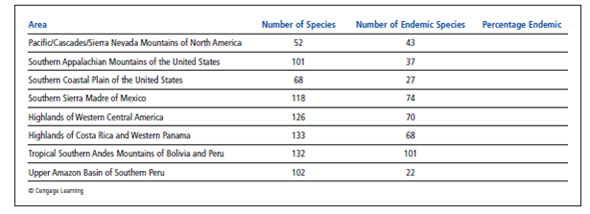
Which two areas have the lowest numbers of endemic species? Which two areas have the lowest percentages of endemic species?

Which two areas have the lowest numbers of endemic species? Which two areas have the lowest percentages of endemic species?
The data is shown below:
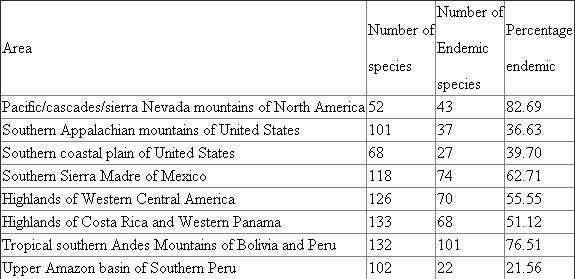 As per the given data, the two areas with lowest number of endemic species are:
As per the given data, the two areas with lowest number of endemic species are:
1. Upper Amazon basin of Southern Peru witH22 endemic species.
2. Southern coastal plain of United States witH27 endemic species.
The two areas with lowest percentage of endemic species are:
1. Upper Amazon basin of southern Peru witH21.56 percent.
2. Southern Appalachian Mountains of United States with 36.63 percent.
 As per the given data, the two areas with lowest number of endemic species are:
As per the given data, the two areas with lowest number of endemic species are:1. Upper Amazon basin of Southern Peru witH22 endemic species.
2. Southern coastal plain of United States witH27 endemic species.
The two areas with lowest percentage of endemic species are:
1. Upper Amazon basin of southern Peru witH21.56 percent.
2. Southern Appalachian Mountains of United States with 36.63 percent.
2
GEOLOGICAL PROCESSES AFFECT BIODIVERSITY
The earth's surface has changed dramatically over its long history. Scientists have discovered that huge flows of molten rock within the earth's interior have broken its surface into a number of gigantic solid plates, called tectonic plates. For hundreds of millions of years, these plates have drifted slowly on the planet's mantle (Figure 4.D).
Rock and fossil evidence indicates that 200-250 million years ago, all of the earth's present-day continents were connected in a supercontinent called Pangaea (Figure 4.D, left). About 135 million years ago, Pangaea began splitting apart as the earth's tectonic plates moved, eventually resulting in the present-day locations of the continents (Figure 4.D, right).
The fact that tectonic plates drift has had two important effects on the evolution and distribution of life on the earth. First, the locations of continents and oceanic basins have greatly influenced the earth's climate and thus have helped to determine where plants and animals can live. Second, the breakup, movement, and joining of continents has allowed species to move, adapt to new environments, and form new species through speciation.
Adjoining tectonic plates that are grinding along slowly next to one another sometimes shift quickly. Such sudden movement of tectonic plates can cause earthquakes, which can also affect biological evolution by causing fissures in the earth's crust that, on rare occasions, can separate and isolate populations of species. Over long periods, this can lead to the formation of new species as each isolated population changes genetically in response to new environmental conditions. Volcanic eruptions that occur along the boundaries of tectonic plates can also affect extinction and speciation by destroying habitats and reducing, isolating, or wiping out populations of species. We discuss these processes in greater detail in Chapter 12.
Critical Thinking
The earth's tectonic plates, including the one you are riding on, typically move at about the rate at which your fingernails grow. If they stopped moving, how might this affect the future biodiversity of the planet?

FIGURE 4.D Over millions of years, the earth's continents have moved very slowly on several gigantic tectonic plates. Question: How might an area of land splitting apart cause the extinction of a species?
The earth's surface has changed dramatically over its long history. Scientists have discovered that huge flows of molten rock within the earth's interior have broken its surface into a number of gigantic solid plates, called tectonic plates. For hundreds of millions of years, these plates have drifted slowly on the planet's mantle (Figure 4.D).
Rock and fossil evidence indicates that 200-250 million years ago, all of the earth's present-day continents were connected in a supercontinent called Pangaea (Figure 4.D, left). About 135 million years ago, Pangaea began splitting apart as the earth's tectonic plates moved, eventually resulting in the present-day locations of the continents (Figure 4.D, right).
The fact that tectonic plates drift has had two important effects on the evolution and distribution of life on the earth. First, the locations of continents and oceanic basins have greatly influenced the earth's climate and thus have helped to determine where plants and animals can live. Second, the breakup, movement, and joining of continents has allowed species to move, adapt to new environments, and form new species through speciation.
Adjoining tectonic plates that are grinding along slowly next to one another sometimes shift quickly. Such sudden movement of tectonic plates can cause earthquakes, which can also affect biological evolution by causing fissures in the earth's crust that, on rare occasions, can separate and isolate populations of species. Over long periods, this can lead to the formation of new species as each isolated population changes genetically in response to new environmental conditions. Volcanic eruptions that occur along the boundaries of tectonic plates can also affect extinction and speciation by destroying habitats and reducing, isolating, or wiping out populations of species. We discuss these processes in greater detail in Chapter 12.
Critical Thinking
The earth's tectonic plates, including the one you are riding on, typically move at about the rate at which your fingernails grow. If they stopped moving, how might this affect the future biodiversity of the planet?

FIGURE 4.D Over millions of years, the earth's continents have moved very slowly on several gigantic tectonic plates. Question: How might an area of land splitting apart cause the extinction of a species?
The earth's surface has changed drastically over a period of years. Huge flows of molten rock in the earth's interior have divided earth into number of tectonic plates which are gigantic solid plates. The fact is that the tectonic plates drift has important effects on evolution and distribution of life on earth. The movement of these tectonic plates should be at a constant rate. Any kind of alterations in the movement such as fast movement of tectonic plates than usual, or stoppage of movement of the tectonic plates changes the biodiversity as follows:
1. If the tectonic plates shift quickly it results in earthquakes changing the biodiversity of earth.
2. It also affects biological evolution by causing fissures in the earth's crust.
3. Rarely this can separate populations of species.
4. It leads to the formation of new species as each isolated population changes genetically in response to new environment.
1. If the tectonic plates shift quickly it results in earthquakes changing the biodiversity of earth.
2. It also affects biological evolution by causing fissures in the earth's crust.
3. Rarely this can separate populations of species.
4. It leads to the formation of new species as each isolated population changes genetically in response to new environment.
3
Define and distinguish among native , nonnative , indicator , and keystone species and give an example of each. What major ecological roles do many amphibian species play ( Core Case Study )? List six factors that contribute to the threats of extinction for frogs and other amphibians. Describe the role of the American alligator as a keystone species. Explain why we should protect sharks.
Depending on the specific roles played by a species in the ecosystem, niches are further classified. The roles are divided into native, nonnative, indicator, and keystone roles. Depending on this, the species are also classified accordingly. Any species can play one or more roles in an ecosystem.
1. Native species : native species are those that try to live and survive in a particular ecosystem. They do not migrate to other ecosystems.
2. Nonnative species : Nonnative species migrate to other ecosystems. Sometimes certain species are deliberately or accidentally introduced into a type of ecosystem where they have to survive, they are also called nonnative species. They spread rapidly in new locations.
Example : Brazil imported some honey bees from Africa to increase honey production. These honey bees displaced some native existing bee population which decreased honey production.
3. Indicator species : Species that give an early response to certain changes in the environment, or an ecosystem are called indicator species. They serve as biological smoke alarms.
Example : some amphibians are classified as indicator species. An apparent correlation in climate change due to atmospheric warming caused extinction of two thirds of known species of frogs in tropical forests of Central and South America.
4. Keystone species : Species that help themselves to sustain the environmental conditions are called keystone species. They have large effect on the types and abundance of other species.
Example : pollination of flowering species by humming birds, bats, and others.
Amphibians like frogs play a major role in serving biological smoke alarm which indicates the changes in atmosphere as well as environment. The factors that lead to the extinction of amphibians are both natural and also created by humans. The major causes leading to the extinction are:
1. Parasites such as flatworms feed on amphibian eggs which is a natural cause. This causes birth defects in amphibians like missing limbs and extra limbs.
2. Viral and fungal diseases that occur on skin of frogs reduce the ability of frogs to absorb water through the skin, leading to dehydration.
3. The clearing of forests and draining and filling of fresh water lands for farming and urban development is human caused reason for extinction of amphibians. This lead to their habitat loss and fragmentation.
4. Prolonged drought also leads to extinction by drying up the breeding pools where frogs and other amphibians reproduce.
5. Human influenced problem such as higher levels of UV radiations also affect the embryos of amphibians in shallow ponds due to the heat of sun.
6. Use of pesticides is also leading to extinction of amphibians when they are exposed in ponds, and also due to a decrease in the insect population they prey.
Role of American alligator as a keystone species : American alligators are hunted for food purpose. Also, its belly is so soft and is used in making of expensive shoes, belts, and so on. This destroyed 90 percent of these alligators and also led to their extinction. As a matter of fact, people did not understand the role of alligators as ecological niches.
1. Alligators help in holding freshwater as they dig deep holes. This freshwater helps during the dry seasons for aquatic life.
2. Their large nesting mounds provide feeding sites for some herons and egrets.
3. These mounds also serve as a place for some turtles to lay their eggs.
4. Alligators feed on gar, a predatory fish and thus help in maintaining population balance between bass and beam the gar feeds on.
5. By their nesting mounds and deep holes they help to keep the shore free from invading vegetation.
Due to these factors alligators serve as keystone species which help in maintaining the sustainability of the ecosystems they exist.
Sharks, as keystone species, play a vital role in maintaining the ecosystem functional. They stay at the top level in the food web removing the sick and injured animals from the ocean. If this free ecosystem of sharks does not exist, then all the oceans might have been filled with dead animals. For their valuable fins, meat, liver, jaws, and for the fear of sharks, almost 73 million sharks are killed every year. Protecting sharks is very important as they help in maintaining the aquatic population balance by decreasing the environmental risks.
1. Native species : native species are those that try to live and survive in a particular ecosystem. They do not migrate to other ecosystems.
2. Nonnative species : Nonnative species migrate to other ecosystems. Sometimes certain species are deliberately or accidentally introduced into a type of ecosystem where they have to survive, they are also called nonnative species. They spread rapidly in new locations.
Example : Brazil imported some honey bees from Africa to increase honey production. These honey bees displaced some native existing bee population which decreased honey production.
3. Indicator species : Species that give an early response to certain changes in the environment, or an ecosystem are called indicator species. They serve as biological smoke alarms.
Example : some amphibians are classified as indicator species. An apparent correlation in climate change due to atmospheric warming caused extinction of two thirds of known species of frogs in tropical forests of Central and South America.
4. Keystone species : Species that help themselves to sustain the environmental conditions are called keystone species. They have large effect on the types and abundance of other species.
Example : pollination of flowering species by humming birds, bats, and others.
Amphibians like frogs play a major role in serving biological smoke alarm which indicates the changes in atmosphere as well as environment. The factors that lead to the extinction of amphibians are both natural and also created by humans. The major causes leading to the extinction are:
1. Parasites such as flatworms feed on amphibian eggs which is a natural cause. This causes birth defects in amphibians like missing limbs and extra limbs.
2. Viral and fungal diseases that occur on skin of frogs reduce the ability of frogs to absorb water through the skin, leading to dehydration.
3. The clearing of forests and draining and filling of fresh water lands for farming and urban development is human caused reason for extinction of amphibians. This lead to their habitat loss and fragmentation.
4. Prolonged drought also leads to extinction by drying up the breeding pools where frogs and other amphibians reproduce.
5. Human influenced problem such as higher levels of UV radiations also affect the embryos of amphibians in shallow ponds due to the heat of sun.
6. Use of pesticides is also leading to extinction of amphibians when they are exposed in ponds, and also due to a decrease in the insect population they prey.
Role of American alligator as a keystone species : American alligators are hunted for food purpose. Also, its belly is so soft and is used in making of expensive shoes, belts, and so on. This destroyed 90 percent of these alligators and also led to their extinction. As a matter of fact, people did not understand the role of alligators as ecological niches.
1. Alligators help in holding freshwater as they dig deep holes. This freshwater helps during the dry seasons for aquatic life.
2. Their large nesting mounds provide feeding sites for some herons and egrets.
3. These mounds also serve as a place for some turtles to lay their eggs.
4. Alligators feed on gar, a predatory fish and thus help in maintaining population balance between bass and beam the gar feeds on.
5. By their nesting mounds and deep holes they help to keep the shore free from invading vegetation.
Due to these factors alligators serve as keystone species which help in maintaining the sustainability of the ecosystems they exist.
Sharks, as keystone species, play a vital role in maintaining the ecosystem functional. They stay at the top level in the food web removing the sick and injured animals from the ocean. If this free ecosystem of sharks does not exist, then all the oceans might have been filled with dead animals. For their valuable fins, meat, liver, jaws, and for the fear of sharks, almost 73 million sharks are killed every year. Protecting sharks is very important as they help in maintaining the aquatic population balance by decreasing the environmental risks.
4
How would you respond to someone who tells you that:
a. he or she does not believe in biological evolution because it is "just a theory"?
b. we should not worry about air pollution because natural selection will enable humans to develop lungs that can detoxify pollutants?
a. he or she does not believe in biological evolution because it is "just a theory"?
b. we should not worry about air pollution because natural selection will enable humans to develop lungs that can detoxify pollutants?

Unlock Deck
Unlock for access to all 27 flashcards in this deck.
Unlock Deck
k this deck
5
Describe the threats to many of the world's amphibian species and explain why we should avoid hastening the extinction of any amphibian species through our activities.

Unlock Deck
Unlock for access to all 27 flashcards in this deck.
Unlock Deck
k this deck
6
The following table is a sample of a very large body of data reported by J. P. Collins, M. L. Crump, and T. E. Lovejoy III in their book Extinction in Our Times-Global Amphibian Decline. It compares various areas of the world in terms of the number of amphibian species found and the number of amphibian species that were endemic, or unique to each area. Scientists like to know these percentages because endemic species tend to be more vulnerable to extinction than do non-endemic species. Study the table below and then answer the following questions.
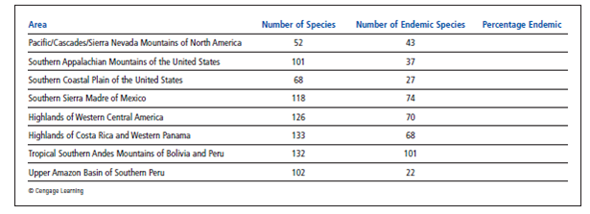
Which two areas have the highest percentages of non-endemic species?

Which two areas have the highest percentages of non-endemic species?

Unlock Deck
Unlock for access to all 27 flashcards in this deck.
Unlock Deck
k this deck
7
How might we and other species be affected if most or all amphibians ( Core Case Study ) were to go extinct?

Unlock Deck
Unlock for access to all 27 flashcards in this deck.
Unlock Deck
k this deck
8
What are the two key concepts for this section? What are fossils and how do scientists use them? Define biological evolution (evolution) and natural selection and explain how they are related. What is the scientific theory of biological evolution through natural selection?

Unlock Deck
Unlock for access to all 27 flashcards in this deck.
Unlock Deck
k this deck
9
The following table is a sample of a very large body of data reported by J. P. Collins, M. L. Crump, and T. E. Lovejoy III in their book Extinction in Our Times-Global Amphibian Decline. It compares various areas of the world in terms of the number of amphibian species found and the number of amphibian species that were endemic, or unique to each area. Scientists like to know these percentages because endemic species tend to be more vulnerable to extinction than do non-endemic species. Study the table below and then answer the following questions.
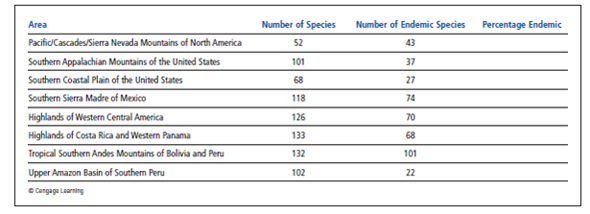
Fill in the fourth column to calculate the percentage of amphibian species that are endemic to each area.

Fill in the fourth column to calculate the percentage of amphibian species that are endemic to each area.

Unlock Deck
Unlock for access to all 27 flashcards in this deck.
Unlock Deck
k this deck
10
How would you respond to someone who says that because extinction is a natural process, we should not worry about the loss of biodiversity when species become extinct largely as a result of our activities?

Unlock Deck
Unlock for access to all 27 flashcards in this deck.
Unlock Deck
k this deck
11
Study an ecosystem of your choice, such as a meadow, a patch of forest, a garden, or an area of wetland. (If you cannot do this physically, do so virtually by reading about an ecosystem online or in a library.) Determine and list five major plant species and five major animal species in your ecosystem. Write hypotheses about (a) which of these species, if any, are indicator species and (b) which of them, if any, are keystone species. Explain how you arrived at your hypotheses. Then design an experiment to test each of your hypotheses, assuming you would have unlimited means to carry them out.

Unlock Deck
Unlock for access to all 27 flashcards in this deck.
Unlock Deck
k this deck
12
What is a mutation and what role do mutations play in evolution through natural selection? What is an adaptation , or adaptive trait ? Explain how harmful bacteria can become genetically resistant to antibiotics. What three genetic adaptations have helped humans to become such a powerful species?

Unlock Deck
Unlock for access to all 27 flashcards in this deck.
Unlock Deck
k this deck
13
Search for Amphibians to find out more about the current state of these species with regard to threats to their existence ( Core Case Study ). What actions are being taken by various nations and organizations to protect amphibians? Write a short summary report on your research.

Unlock Deck
Unlock for access to all 27 flashcards in this deck.
Unlock Deck
k this deck
14
What role does each of the following processes play in helping to implement the three scientific principles of sustainability : (a) natural selection, (b) speciation, and (c) extinction?

Unlock Deck
Unlock for access to all 27 flashcards in this deck.
Unlock Deck
k this deck
15
INSECTS PLAY A VITAL ROLE IN OUR WORLD
We classify many insect species as pests because they compete with us for food, spread human diseases such as malaria, bite or sting us, and invade our lawns, gardens, and houses. Some people fear insects and many think the only good bug is a dead bug. They fail to recognize the vital roles insects play in helping to sustain life on the earth.
For example, pollination is a vital ecosystem service that allows flowering plants to reproduce sexually when pollen grains are transferred from the flower of one plant to a receptive part of the flower of another plant of the same species. Many of the earth's plant flowering species depend on insects to pollinate their flowers (Figure 4.A, left). Also, insects that eat other insects-such as the praying mantis (Figure 4.A, right)-help to control the populations of at least half the insect species we call pests. This free source of pest control is another vital ecosystem service.
Certain environmental changes, some of them caused by human activities, are threatening insect populations and their ecosystem services around the world. Entomologists -scientists who study insects-are expanding their research in areas related to such environmental threats. For example, entomologist Diana Cox-Foster of Pennsylvania State University is studying the decline of honeybees, which are extremely important pollinators.
This decline threatens to disrupt whole ecosystems that depend on bees for pollination, as well as much of the human food supply. We discuss this serious environmental problem more fully in Chapter 8.
Critical Thinking
Can you think of three insect species not discussed above that benefit your life?
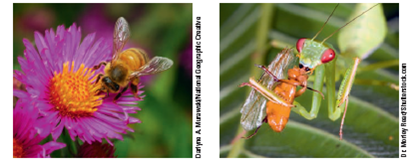
FIGURE 4.A Importance of insects: Bees (left) and numerous other insects pollinate flowering plants that serve as food for many plant eaters, including humans. This praying mantis, which is eating a moth (right), and many other insect species help to control the populations of most of the insect species we classify as pests.
We classify many insect species as pests because they compete with us for food, spread human diseases such as malaria, bite or sting us, and invade our lawns, gardens, and houses. Some people fear insects and many think the only good bug is a dead bug. They fail to recognize the vital roles insects play in helping to sustain life on the earth.
For example, pollination is a vital ecosystem service that allows flowering plants to reproduce sexually when pollen grains are transferred from the flower of one plant to a receptive part of the flower of another plant of the same species. Many of the earth's plant flowering species depend on insects to pollinate their flowers (Figure 4.A, left). Also, insects that eat other insects-such as the praying mantis (Figure 4.A, right)-help to control the populations of at least half the insect species we call pests. This free source of pest control is another vital ecosystem service.
Certain environmental changes, some of them caused by human activities, are threatening insect populations and their ecosystem services around the world. Entomologists -scientists who study insects-are expanding their research in areas related to such environmental threats. For example, entomologist Diana Cox-Foster of Pennsylvania State University is studying the decline of honeybees, which are extremely important pollinators.
This decline threatens to disrupt whole ecosystems that depend on bees for pollination, as well as much of the human food supply. We discuss this serious environmental problem more fully in Chapter 8.
Critical Thinking
Can you think of three insect species not discussed above that benefit your life?

FIGURE 4.A Importance of insects: Bees (left) and numerous other insects pollinate flowering plants that serve as food for many plant eaters, including humans. This praying mantis, which is eating a moth (right), and many other insect species help to control the populations of most of the insect species we classify as pests.

Unlock Deck
Unlock for access to all 27 flashcards in this deck.
Unlock Deck
k this deck
16
What are two limitations on evolution through natural selection? What are four common myths about evolution through natural selection, and for each of them, why is it a myth?

Unlock Deck
Unlock for access to all 27 flashcards in this deck.
Unlock Deck
k this deck
17
What is the key concept for this section? Define biodiversity (biological diversity) and list and describe its four major components. Why is biodiversity important? Summarize the importance of insects. Define and give three examples of biomes. Summarize the scientific contributions of Edward O. Wilson.

Unlock Deck
Unlock for access to all 27 flashcards in this deck.
Unlock Deck
k this deck
18
List three aspects of your lifestyle that could be contributing to some of the losses of the earth's biodiversity. For each of these, what are some ways to avoid making this contribution?

Unlock Deck
Unlock for access to all 27 flashcards in this deck.
Unlock Deck
k this deck
19
Is the human species a keystone species? Explain. If humans were to become extinct, what are three species that might also become extinct and what are three species whose populations would probably grow?

Unlock Deck
Unlock for access to all 27 flashcards in this deck.
Unlock Deck
k this deck
20
What are the two key concepts for this section? Define speciation. Distinguish between geographic isolation and reproductive isolation , and explain how they can lead to the formation of a new species. Explain how geological processes can affect biodiversity. Define and distinguish between artificial selection and genetic engineering and give an example of each. Define synthetic biology.

Unlock Deck
Unlock for access to all 27 flashcards in this deck.
Unlock Deck
k this deck
21
The following table is a sample of a very large body of data reported by J. P. Collins, M. L. Crump, and T. E. Lovejoy III in their book Extinction in Our Times-Global Amphibian Decline. It compares various areas of the world in terms of the number of amphibian species found and the number of amphibian species that were endemic, or unique to each area. Scientists like to know these percentages because endemic species tend to be more vulnerable to extinction than do non-endemic species. Study the table below and then answer the following questions.
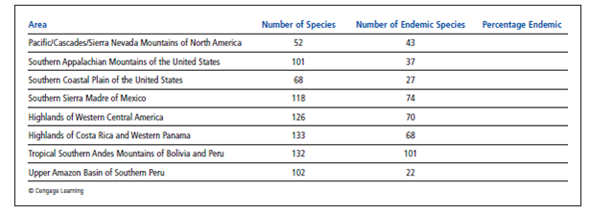
Which two areas have the highest numbers of endemic species? Name the two areas with the highest percentages of endemic species.

Which two areas have the highest numbers of endemic species? Name the two areas with the highest percentages of endemic species.

Unlock Deck
Unlock for access to all 27 flashcards in this deck.
Unlock Deck
k this deck
22
Congratulations! You are in charge of the future evolution of life on the earth. What are the three things that you would consider to be the most important to do?

Unlock Deck
Unlock for access to all 27 flashcards in this deck.
Unlock Deck
k this deck
23
SCIENTISTS ARE SEARCHING FOR THE CAUSES OF AMPHIBIAN DECLINES
H erpetologists, the scientists who study frogs and other amphibians, have identified a number of factors-both natural and human-caused-that threaten these species at various points in their life cycles. One of the natural causes is parasites such as flatworms that feed on certain amphibian eggs. Scientists think this has caused birth defects such as missing limbs or extra limbs in some amphibians.
Some herpetologists hypothesize that viral and fungal diseases, especially the chytrid fungus (Figure 4.B) that attacks the skin of frogs, are reducing the frogs' ability to ingest water through their skin. This leads to death from dehydration. Such diseases can spread fairly easily, because adults of many amphibian species congregate in large numbers to breed.
Another major threat to amphibians is habitat loss and fragmentation. This is mostly a human-caused problem resulting from the clearing of forests and the draining and filling of freshwater wetlands for farming and urban development. Another threat is prolonged drought, which can dry up breeding pools that frogs and other amphibians depend on for reproduction and survival through their early stages of life (Figure 4.C).
Another human-influenced problem is higher levels of UV radiation, which can harm embryos of amphibians in shallow ponds as well as adults basking in the sun for warmth. Historically, such radiation has been screened by ozone in the stratosphere, but during the past few decades, ozone-depleting chemicals released into the troposphere from human sources have drifted upward into the stratosphere and destroyed some of the protective ozone found there.
Pollution is another human-caused threat to amphibians. Frogs and other species are increasingly exposed to pesticides in ponds and in the bodies of insects that they eat. This can make them more vulnerable to bacterial, viral, and fungal diseases and to some parasites. Amphibian expert and National Geographic Explorer Tyrone Hayes, a professor of biology at University of California, Berkeley, is conducting research on how some pesticides can harm frogs and other animals by disrupting their endocrine systems.
Overhunting is another problem, especially in areas of Asia and Europe, where frogs are hunted for their leg meat. Yet another threat is the invasion of amphibian habitats by nonnative predators and competitors, such as certain fish species. Some of this immigration is natural, but humans accidentally or deliberately transport many species to amphibian habitats.
Most herpetologists believe that a combination of these factors, which vary from place to place, probably is responsible for most of the decline and disappearances among amphibian species.
Critical Thinking
Of the factors listed above, which three do you think could be most effectively controlled by human efforts?
FIGURE 4.B Frogs killed by the chytrid fungus at a high-elevation lake in California.
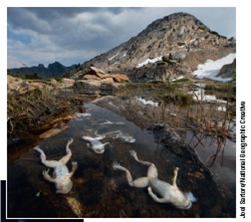

FIGURE 4.C This golden toad lived in Costa Rica's high-altitude Monteverde Cloud Forest Reserve. The species became extinct in 1989, apparently because its habitat dried up.
H erpetologists, the scientists who study frogs and other amphibians, have identified a number of factors-both natural and human-caused-that threaten these species at various points in their life cycles. One of the natural causes is parasites such as flatworms that feed on certain amphibian eggs. Scientists think this has caused birth defects such as missing limbs or extra limbs in some amphibians.
Some herpetologists hypothesize that viral and fungal diseases, especially the chytrid fungus (Figure 4.B) that attacks the skin of frogs, are reducing the frogs' ability to ingest water through their skin. This leads to death from dehydration. Such diseases can spread fairly easily, because adults of many amphibian species congregate in large numbers to breed.
Another major threat to amphibians is habitat loss and fragmentation. This is mostly a human-caused problem resulting from the clearing of forests and the draining and filling of freshwater wetlands for farming and urban development. Another threat is prolonged drought, which can dry up breeding pools that frogs and other amphibians depend on for reproduction and survival through their early stages of life (Figure 4.C).
Another human-influenced problem is higher levels of UV radiation, which can harm embryos of amphibians in shallow ponds as well as adults basking in the sun for warmth. Historically, such radiation has been screened by ozone in the stratosphere, but during the past few decades, ozone-depleting chemicals released into the troposphere from human sources have drifted upward into the stratosphere and destroyed some of the protective ozone found there.
Pollution is another human-caused threat to amphibians. Frogs and other species are increasingly exposed to pesticides in ponds and in the bodies of insects that they eat. This can make them more vulnerable to bacterial, viral, and fungal diseases and to some parasites. Amphibian expert and National Geographic Explorer Tyrone Hayes, a professor of biology at University of California, Berkeley, is conducting research on how some pesticides can harm frogs and other animals by disrupting their endocrine systems.
Overhunting is another problem, especially in areas of Asia and Europe, where frogs are hunted for their leg meat. Yet another threat is the invasion of amphibian habitats by nonnative predators and competitors, such as certain fish species. Some of this immigration is natural, but humans accidentally or deliberately transport many species to amphibian habitats.
Most herpetologists believe that a combination of these factors, which vary from place to place, probably is responsible for most of the decline and disappearances among amphibian species.
Critical Thinking
Of the factors listed above, which three do you think could be most effectively controlled by human efforts?
FIGURE 4.B Frogs killed by the chytrid fungus at a high-elevation lake in California.


FIGURE 4.C This golden toad lived in Costa Rica's high-altitude Monteverde Cloud Forest Reserve. The species became extinct in 1989, apparently because its habitat dried up.

Unlock Deck
Unlock for access to all 27 flashcards in this deck.
Unlock Deck
k this deck
24
What is extinction ? What is an endemic species and why can such a species be vulnerable to extinction? Define and distinguish between the background extinction rate and a mass extinction. What is one of the leading causes of the rising rate of extinction?

Unlock Deck
Unlock for access to all 27 flashcards in this deck.
Unlock Deck
k this deck
25
What are the two key concepts for this section? Define and distinguish between a niche , or ecological niche , and a habitat. Distinguish between generalist species and specialist species and give an example of each.

Unlock Deck
Unlock for access to all 27 flashcards in this deck.
Unlock Deck
k this deck
26
What are this chapter's three big ideas ? How are ecosystems where amphibians and other species live functioning examples of the three scientific principles of sustainability ?

Unlock Deck
Unlock for access to all 27 flashcards in this deck.
Unlock Deck
k this deck
27
If you were forced to choose between saving the giant panda from extinction and saving a shark species, which would you choose? Explain.

Unlock Deck
Unlock for access to all 27 flashcards in this deck.
Unlock Deck
k this deck



